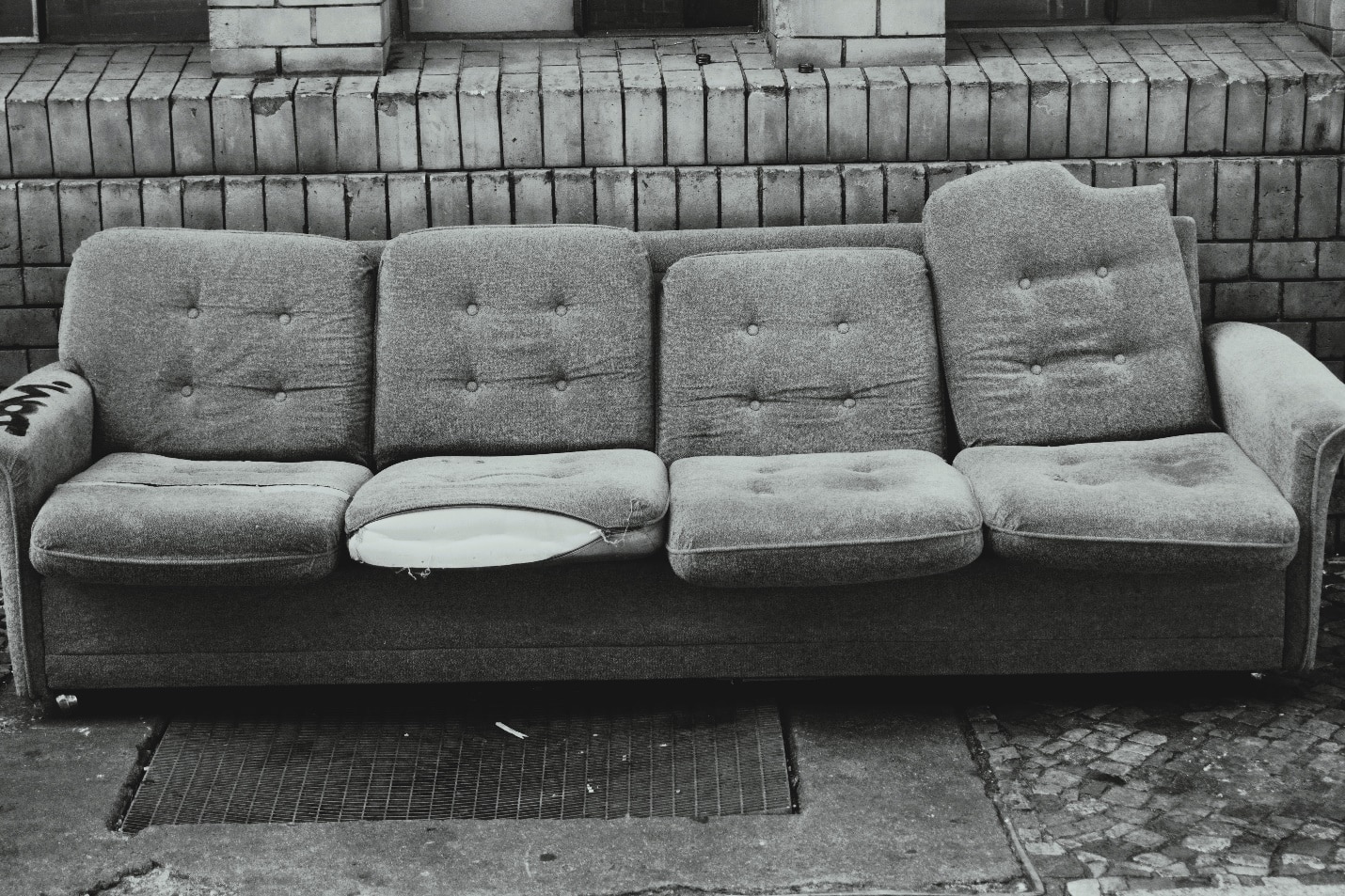Sofas are more than just a necessary part of our living room. They hold a sentimental value that is a constant witness to cozy moments and cherished memories. They play a central role in creating a sense of comfort and belonging, essentially a symbol of relaxation, connection among family members, and personal sanctuary. Unfortunately, despite how much we think they would last forever, they have a limited lifespan and, sometimes, reach a point where they may have outlived their primary purpose.
There are many paths to take when you believe your sofa is already up for retirement, depending on its usability and your emotional attachment. Even with the inevitable time limit, you can still take measures to extend their longevity, upcycle to make use of the still usable parts, and make informed decisions regarding their responsible disposal.
Extending your Sofa’s Lifespan
Your couch’s capability to extend its lifespan starts at the first stage of purchasing one. It is important to look at quality over price to accurately weigh which is the more cost-effective choice. As every homeowner is aware, choosing the most fitting sofa takes time. There are a lot of factors to consider, as you will be welcoming this valued piece of furniture to the majority of your home life. Check out this article to guide you in making the top-quality choice.
When you finally settle on the perfect couch, and it finds its way to your home, there are upkeep procedures you can take to ensure that this sofa accompanies you in your every life milestone.
- Regularly rotate and flip the cushions on your sofa, if able, to distribute the wear evenly.
- Consider using slipcovers to protect your couch from stains, spills, and general wear and tear. Choose slipcovers that are easy to clean as well and one that can be easily changed for a fresher look.
- Maintain a consistent cleaning schedule, which includes vacuuming to remove dust and any debris. You also need to note that some sofa materials require a specific cleaning process and may be sensitive to harmful chemicals, so be sure to follow the manufacturer’s cleaning recommendations.
- Keep pets in mind if you have one. You can place a pet-friendly cover on the furniture to prevent scratches, fur, and stains. Regular pet grooming also translates to less fur and occasions of scratches, so be sure to avoid skipping your pet’s appointment with its groomers.
- Avoid placing your sofa outdoors or in areas where they have extended exposure to sunlight. Regular sun exposure can cause the upholstery to fade and weaken over time, which ultimately speeds up its deterioration.
- Exercise caution with sharp objects around the sofa. These objects could puncture or tear the fabric, compromising the furniture’s overall durability.
- Include a regular maintenance checkup on your sofa with every cleanup session. Tighten the legs or frame periodically, if necessary, as loose bolts or screws can lead to instability and irreversible damage.
- Have your sofa professionally cleaned and maintained every few years. Regular cleanups cannot remove deep-seated dirt and stains, which can be an easy fix for these professionals.
Upcycling your Sofa When it is Time

When your couch is way past its prime and has endured several occasions of wear and tear that it is no longer practical to maintain, consider the possibility of giving it a new life before ultimately bidding farewell. The art of upcycling is a welcome gesture to reducing waste, infusing creativity into your home, and preserving the sentimental value of your furniture.
Upcycling is where you take old, discarded, or unused items and repurpose them into a new object of higher quality or value. It is a sustainable practice of reviving items that might otherwise be disposed of in landfills, adding creativity to transforming valued furniture into something even more functional.
The process of transforming an old item into a new one may be a long, arduous, and sometimes pricey task, but it doesn’t have to be when you make it a fun family or friendship activity. Here are some creative DIY projects that you can do with your old sofas:
- From a day lounge to a daybed: Turn your old sofa into a stylish daybed by removing the backrest and any elements unnecessary for a bed structure. You can add cozy elements like a throw pillow or some cushions to add character.
- From sofa armrest to a functional table: When the upholstery is beyond saving, salvage the sturdy armrests and transform them into side tables. With a touch of polished wood surface, you have created a convenient space for drinks, books, and even decorative items during holidays.
- From a sofa frame to a sturdy outdoor swing: If the wooden frames are still durable, remove them from underneath the upholstery and give them a new life with fresher paint and some ropes and chains. You can turn them into a fully functional, unique garden swing.
- From full-on sofa to space saver ottoman: Give your cushions a new lease on life by converting them into stylish and functional ottomans. If necessary, you can reupholster them and add sturdy legs to create versatile furniture that can serve as a footrest or for seating.
- From plain sofa to storage bench: a great way to repurpose your couch is to transform it into a more functional storage space. You can remove the backrest and add a hinged lid to maintain its comfortable seating function but with a built-in storage twist.
Your Sofa’s Ultimate End by Responsible Disposal
When your beloved lounge furniture has finally served its purpose up until the last moments, or you have to make changes in your home to save space, the remaining option is to dispose of it responsibly. Ironically, this may be the most challenging task as it is laden with some emotional reluctance to let it go and the overwhelming logistical implications.
The thought of such a big responsibility may paralyze you with an all-consuming sense of impossibility. However, breaking it down into smaller tasks can make this a manageable feat that can be completed quickly.
- You can start by checking your local regulations and guidelines for furniture disposal to ensure proper compliance and avoid any fines.
- If you assess that the sofa is too big to pass through your doors or windows, or you have gone through some house renovations, making it challenging to navigate, you can safely dismantle the parts. Start by removing any nails, screws, or metal parts.
- Contact waste management companies to arrange for pickup. Most of them have environmentally friendly practices in place to ensure that your furniture is handled responsibly. You can read more here at ridlyrubbishremoval.com.au about their best practices for rubbish removal services.
- If your sofa is still in good condition, consider donating it or exploring the buy/sell platforms. You may find some neighbors or someone in the nearby area who are into DIY projects and are super into repurposing or refurbishing old pieces of furniture.
- You can also contact the sofa manufacturer and inquire if they have a take-back program, where you can trade it in for a new sofa with a discount.

When it comes to old furniture disposal, the first thing to remember is always to choose the more sustainable path. Regardless of your method, it is your responsibility as the furniture owner to ensure that your couch is in an environmentally responsible way to minimize its impact on the environment.
Never resort to illegal dumping by just abandoning them on the street or any unauthorized areas, which does not only harm the surroundings but can also result in penalties. It is always better to consult your local authorities or rubbish removal professionals for advice on proper furniture disposal.
The amount of love you’ve placed in your sofa as it accumulates memories over the years should also be the same in making sure they return to nature in the most natural way possible — and rotting in landfills or any abandoned area is not the best way to show it. By making conscious choices and understanding its impact on the environment, it can hold its significance both during and after its lifespan.





